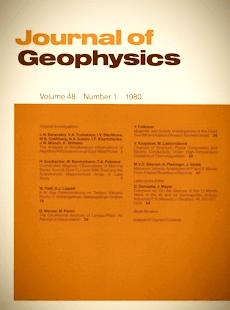The simulation problem for broad-band seismograms
Article Sidebar

Vols. 1-18 (1924-1944), ISSN 0044-2801
Main Article Content
Abstract
A fundamental problem in the numerical data preprocessing of digital broad-band seismograms is the simulation of arbitrary analog seismograph systems, especially seismometer-galvanometer combinations. A special case of this simulation problem is the deconvolution or restitution problem as the realization of a wide-band seismograph system with a transfer function proportional to ground displacement, velocity or acceleration. The simulation problem can be solved by a digital cascade recursive filter using the bilinear z-transformation. Applications of the simulation filter are: a combined interpretation of digital broad-band and analog narrow-band recordings, a routine analysis of broad-band seismograms consistent with ordinary analog stations, the determination of the local magnitude from simulated Wood-Anderson seismograms and the restitution of broad-band recordings. The relationship between bandwidth, fine structure and information content of seismograms can be demonstrated in an obvious way by comparing broad-band recordings of the Graefenberg-array with simulated seismograms for different standardized seismometer-galvanometer systems.
 ARK: https://n2t.net/ark:/88439/y024704
ARK: https://n2t.net/ark:/88439/y024704
Permalink: https://geophysicsjournal.com/article/108
Article Details
References
Beauchamp, K.G. (1973) Signal processing. George Allen & Unwin LTD, London
Chakrabarty, S.K., Choudhury, G.C., Roy Choudhery, S.N. (1964) Magnification curves of electromagnetic seismographs. Bull. Seismol. Soc. Am. 54:1459-1471
Harjes, H.-P., Seidl, D. (1978) Digital recording and analysis of broadband seismic data at the Graefenberg (GRF)-array. J. Geophys. 44:511-523
Kaiser, J.F. (1963) Design methods for sampled data filters. Proc. 1st Annu. Allerton Conf. Circuit System Theory pp. 221-236
Kind, R. (1979) Observations of sPn from Swabian Alb earthquakes at the GRF array. J. Geophys. 45:337-340
Muller, G., Bonjer, K.-P., Stockl, H., Enescu, D. (1978) The Romanian earthquake of March 4, 1977. I. Rupture process inferred from fault-plane solution and multiple-event analysis. J. Geophys. 44:203-218
Peterson, J., Butler, H.M., Holcomb, L.G., Hutt, C.R. (1976) The Seismic Research Observatory. Bull. Seismol. Soc. Am. 66:2049-2068
Savarenski, E.F., Kirnos, D.P. (1960) Elemente der Seismologie und Seismometrie. Akademie-Verlag, Berlin
Savill, R.A., Carpenter, E.W., Wright, J.K. (1962) The derivation and solution of indicator equations for seismometer-galvanl)meter combinations including the effect of seismometer inductance. Geophys. J. R. Atron. Soc. 6:409-425
Stoll, D. (1979) Spektralanalyse seismischer Wellen zur Beschreibung des Scherbruches bei den Erdbeben in Friaul (1976), 48 pp. Diplomarbeit, University of Stuttgart, Germany
Streckeisen, G. (1978) Wide-band feedback seismograph system STS-1 V/STS-1 H. Prospekt der Firma G. Streckeisen MeBgeratebau, Buchsweg 17, CH-8400 Winthertur, Switzerland
Wielandt, E. (1970) Ein einfacher elektronischer Entzerrer fur Seismometer. J. Geophys. 36:763-769
Wielandt, E. (1973) Noise in electronic seismograph systems. J. Geophys. 39:597-602
Wielandt, E. (1975) Ein astasiertes Vertikalpendel mit tragender Blattfeder. J. Geophys. 41:545-547
Wielandt, E., Mitronovas, W. (1976) An electronic long-period seismograph for surface-wave dispersion studies. Bull. Seismol. Soc. Am. 66:987-996
Willmore, P.L., Karnik, V. (1970) Manual of seismological observatory practice. International Seismological Centre Edinburgh, UK
Proceedings (1973) Seminar on deconvolution of seismograms and high-fidelity seismometry. J. Geophys. 39:501-626











